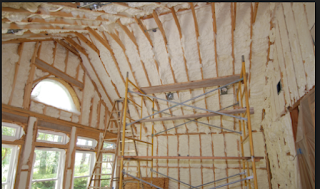Spray Foam Insulation – To Ventilate or Not

Open cell and closed cell foam insulation has been used in many homes for some time now. We will take a closer look at closed cell foam. Isocyanate mixed with Polyol Resin form closed cell spray foam insulation. Closed cell spray foam insulation has one of the highest “R” values. Closed cell foam averages R-6 to R-7 per inch. Compare this to one inch of fiberglass that is just above R-3. Some of the benefits of spray foam insulation are: added structural integrity, impervious to moisture, will not settle or split, and increased sound control. Closed cell insulation is by design a vapor barrier and does not require an additional vapor barrier. Many builders are spray foaming the underside of the roof deck and completely eliminating attic / roof ventilation. Creating a closed, sealed building envelope. Some experts recommend not ventilating the attic space when closed cell spray foam insulation is used because they feel that it is not necessary. We, as home inspectors have been telling our clients for years that attic ventilation is necessary for moisture control, extending the serviceable life of asphalt roof shingles, and controlling ice damming. Spray foam, if installed properly should eliminate moisture and because of the high R value, also control ice damming. But what about roof leaks and possible premature aging of asphalt roof shingles. First we will take a look at the moisture issue.
Some experts think that in certain weather conditions like extreme cold or high heat the temperature difference between the exposed shingles and the interior spray foam insulation may cause humidity or condensation to occur. Moisture could form between the vapor barrier (roof paper / synthetic underlayment) and the roof deck. This could cause the deck to deteriorate with no prior indication.
Some asphalt roof shingle manufactures recommend against installing spray foam directly on the underside of the roof sheathing. This is sometimes called a “hot roof”. The lack of ventilation allows high heat buildup which is the primary cause of asphalt roof shingle wear. Some studies show an increased temperature difference between 2 – 9° F on shingles installed on roofs without ventilation. Other studies show even higher temperatures during certain times of the day.
Click here for the Asphalt Roofing Manufactures Association “Technical Bulletin” regarding their position on asphalt shingles over insulated decks.
My personal recommendation to my clients: you can have the best of both worlds. I recommend installing proper roof ventilation using baffles from soffit to ridge, and then spray foaming over the baffles. This will ensure proper ventilation, will not affect the shingle warranty, and will allow for easy replacement of the roof deck if necessary.
Home inspectors are always looking for adequate roof ventilation. I have lost count the amount of times I have recommended clients install additional soffit vents. Hidden triple vents are a great option. They provide 1.47 square inches of ventilation per linear foot, or 1.77 square inches per square foot. Hidden vents add to the beauty of the house while still providing adequate ventilation.
Related Articles:
- Unvented Attic Space
- Solution Series – Roof Venting
- Spray Foam Insulation
- How Important is Attic access?
Want To Learn More? Click HERE to Search Our Full Database Of Home Inspector Newsletters.



